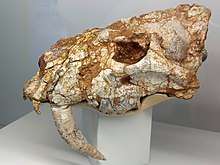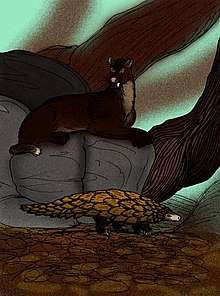Barbourofelidae
Barbourofelidae is an extinct family of carnivorans of the suborder Feliformia that lived in North America, Eurasia and Africa during the Miocene epoch (16.9—9.0 million years ago) and existed for about 7.9 million years.[2]
| Barbourofelidae | |
|---|---|
 | |
| Barbourofelis loveorum at the Florida Museum of Natural History | |
| Scientific classification | |
| Kingdom: | Animalia |
| Phylum: | Chordata |
| Class: | Mammalia |
| Order: | Carnivora |
| Suborder: | Feliformia |
| Family: | †Barbourofelidae Schultz, et al., 1970[1] |
| Genera | |
| |
Taxonomy
The type genus, Barbourofelis, was originally described by Schultz et al. (1970) and assigned to a new tribe, Barbourofelini, within the felid subfamily Machairodontinae, along with the other sabre-toothed cats.[3] Subsequently, the tribe was reassigned to the Nimravidae by Tedford (1978) and raised subfamily by Bryant (1991). [4][2] However, a number of studies in the early 2000s identified a closer affinity of the barbourofelines to the Felidae than to the Nimravidae[5] and they were reranked as a distinct family by Morlo et al. (2004)[2] Since then the prevailing view has the barbourofleids as the sister group to the Felidae,[6] although this has recently by challenged following the description of the middle Miocene genus Oriensmilus from northern China, which provided evidence, mainly based on basicranial morphology, that barbourofelids may be more closely related to nimravids than to felids.[7]
Barbourofelids first appear in the fossil record in the Early Miocene of Africa. By the end of the Early Miocene, a land bridge had opened between Africa and Eurasia, allowing for a faunal exchange between the two continents. Barbourofelids migrated at least three times from Africa to Europe.[8] While the genus Sansanosmilus evolved in Europe, barbourofelids also migrated through Eurasia and reached North America by the late Miocene, represented there solely by the genus Barbourofelis.
Classification
| Tribe | Image | Genus | Species |
|---|---|---|---|
| †Ginsburgsmilus (Morales, Salesa, Pickford, & Soria; 2001) |
| ||
| †Syrtosmilus |
| ||
| †Vampyrictis |
| ||
| †Afrosmilini | †Afrosmilus |
| |
| †Prosansanosmilus (Heizmann, Ginsburg, & Bulot; 1980) |
| ||
| †Barbourofelini |  |
†Albanosmilus (Kretzoi, 1929) |
|
 |
†Barbourofelis (Schultz, Schultz & Martin; 1970) |
| |
 |
†Sansanosmilus (Kretzoi, 1929) |
|
Phylogeny
The phylogenetic relationships of Barbourofelidae are shown in the following cladogram:[9][10]
| †Barbourofelidae |
| ||||||||||||||||||||||||||||||||||||||||||||||||||||||||||||||||||||||||||||||
References
- "Paleobiology Database (Barbourofelidae)". Retrieved 19 Oct 2012.
- Michale Morlo; Stéphane Peigné & Doris Nagel (January 2004). "A new species of Prosansanosmilus: implications for the systematic relationships of the family Barbourofelidae new rank (Carnivora, Mammalia)". Zoological Journal of the Linnean Society. 140 (1): 43. doi:10.1111/j.1096-3642.2004.00087.x.
- Schultz, C. B.; Schultz, M.; Martin, L. D. (1970). "A new Tribe of Saber-toothed cats (Barbourofelini) from the Pliocene of North America". Bulletin of the Nebraska State Museum. 9 (1): 1–31.
- Bryant, H. N. (1991). "Phylogenetic Relationships and Systematics of the Nimravidae (Carnivora)". Journal of Mammalogy. 72 (1): 56–78. doi:10.2307/1381980. ISSN 1545-1542. JSTOR 1381980.
- Lars W. van den Hoek Ostende; Michael Morlo & Doris Nagel (July 2006). "Fossils explained 52 Majestic killers: the sabre-toothed cats". Geology Today. 22 (4): 150. doi:10.1111/j.1365-2451.2006.00572.x.
- Werdelin, L.; Yamaguchi, N.; Johnson, W. E. & O'Brien, S. J. (2010). "Phylogeny and evolution of cats (Felidae)". In Macdonald, D. W. & Loveridge, A. J. (eds.). Biology and Conservation of Wild Felids. Oxford, UK: Oxford University Press. pp. 59–82. ISBN 978-0-19-923445-5.
- Xiaoming Wang; Stuart C. White; Jian Guan (2020). "A new genus and species of sabretooth, Oriensmilus liupanensis (Barbourofelinae, Nimravidae, Carnivora), from the middle Miocene of China suggests barbourofelines are nimravids, not felids". Journal of Systematic Palaeontology. Online edition (9): 783–803. doi:10.1080/14772019.2019.1691066.
- Michael Morlo (2006). "New remains of Barbourofelidae from the Miocene of Southern Germany: implications for the history of barbourid migrations". Beiträge zur Paläontologie, Wien. 30: 339–346.
- Josep M. Robles , David M. Alba , Josep Fortuny , Soledad De Esteban-Trivigno , Cheyenn Rotgers , Jordi Balaguer , Raül Carmona , Jordi Galindo , Sergio Almécija , Juan V. Bertó & Salvador Moyà-Solà , Journal of Systematic Palaeontology (2013): New craniodental remains of the barbourofelid Albanosmilus jourdani (Filhol, ) from the Miocene of the Vallès-Penedès Basin (NE Iberian Peninsula) and the phylogeny of the Barbourofelini, Journal of Systematic Palaeontology, DOI:10.1080/14772019.2012.724090
- Werdelin, L.; Yamaguchi, N.; Johnson, W. E.; O'Brien, S. J. (2010). "Phylogeny and evolution of cats (Felidae)". In Macdonald, D. W.; Loveridge, A. J. (eds.). Biology and Conservation of Wild Felids. Oxford, UK: Oxford University Press. pp. 59–82. ISBN 978-0-19-923445-5.